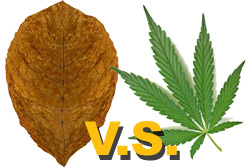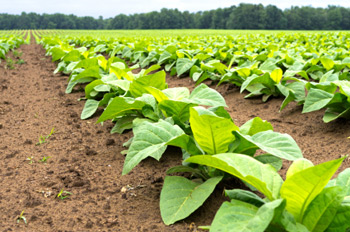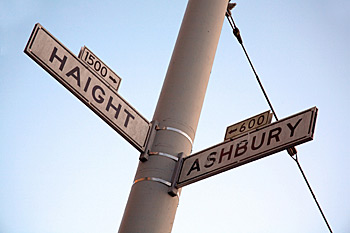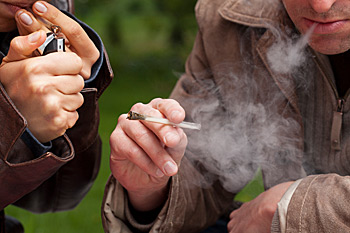Fred Brown
 Here is the irony: In a time when the nation is legalizing marijuana, it is demonizing tobacco. In a time when marijuana’s drawbacks are being overlooked, or just not mentioned, tobacco’s worst characteristics are being loudly touted. And in a time when states are looking to jump on the marijuana bandwagon in order to reap the revenue rewards, tobacco is being bashed by punitive taxes and bans across the spectrum.
Here is the irony: In a time when the nation is legalizing marijuana, it is demonizing tobacco. In a time when marijuana’s drawbacks are being overlooked, or just not mentioned, tobacco’s worst characteristics are being loudly touted. And in a time when states are looking to jump on the marijuana bandwagon in order to reap the revenue rewards, tobacco is being bashed by punitive taxes and bans across the spectrum.
Tobacco’s early history has been pushed to the trash heap. Once, it was a crop this nation counted on to square its debts with foreign nations. It was a crop that was highly sought in foreign markets and sold worldwide. Kentucky burley tobacco was shipped to Europe in hogsheads and some of it returned to the U.S. in the form of pipe tobacco in the 18th and 19th Centuries. Does that sound familiar? It should.
Tobacco in the U.S., and the world, has had a long and plagued history. Even King James I of England preached against the evils of tobacco in the 1600s. When he couldn’t douse the flames, he taxed the leaf.
Since tobacco’s first introductions to the Old World and the New World, it has had its detractors or “antis” as they are known today. Tobacco’s critics have long tried to stamp it out, with no success.
Literature is littered with the greats who have extolled tobacco’s many uses.
No less a literary lion than Samuel Johnson in the 1600s said tobacco (very popular in snuff as well as pipes at the time) “preserved the mind from total vacuity.”
Yes, tobacco, too, was once a large plantation operation in pre-American Revolutionary days. Later it became an economic stimulus for small southern farmers who counted on tobacco to make money to clothe and feed their families.
 But, when tobacco got hijacked by big cigarette manufacturers, it turned into a product peopled loved to hate and to demonize.
But, when tobacco got hijacked by big cigarette manufacturers, it turned into a product peopled loved to hate and to demonize.
In the 1960s when the first Surgeon General’s report on smoking and tobacco emerged, it was met with a kind of reluctant recognition. Most who smoked cigarettes at the time were aware that their health was being affected by cigarettes, but many were willing to smoke anyway.
Those of us who did not enjoy cigarettes turned to the pipe, which was not specifically mentioned in the first SG report. It still isn’t in the latest 2014 report—The Health Consequences of Smoking—50 Years of Progress A Report of the Surgeon General 2014 U.S. DEPARTMENT OF HEALTH AND HUMAN SERVICES Public Health Service Office of the Surgeon General Rockville, MD.
There is scant reference to pipes and pipe tobacco in that publication, which is available at the Surgeon General’s web site.
There is this mention: Most estimates of SAM (Smoking-Attributable Mortality) do not include mortality caused by cigar smoking, pipe smoking, or smokeless tobacco use. For example, an estimated 1,000 deaths in the United States were attributable to pipe smoking in 1991 (Nelson et al. 1996). This limitation reflects the lack of appropriate RRs (relationship of relative risk) related to tobacco products other than cigarettes. To date, these products cause many fewer deaths than cigarettes. However, given the dynamic nature of the tobacco-related environment, assessment of risk due to other tobacco products use is an emerging priority, particularly because of the introduction of tobacco products claiming to reduce exposure (Samet and Wipfli 2009) and increased dual use of tobacco products (Tomar et al. 2010). Dual use (i.e., use of cigarettes and another product) may complicate estimation of SAM, particularly if dual use extends to persons in age ranges where most smoking-caused deaths occur. . . . .
Deaths from cigar smoking, pipe smoking, and smokeless tobacco use were not included in these estimates, nor were deaths from fires and exposure to secondhand smoke for the period of 1965–1999.
 In the 1960s—the “Make Love, Not War” Generation–Haight-Asbury in San Francisco was ablaze with marijuana and cigarettes as well. Pipe smoking was something you did with marijuana, and very few smokers filled their pipes with plain old tobacco.
In the 1960s—the “Make Love, Not War” Generation–Haight-Asbury in San Francisco was ablaze with marijuana and cigarettes as well. Pipe smoking was something you did with marijuana, and very few smokers filled their pipes with plain old tobacco.
Oh, sure, pipe-smoking “geezers” were prevalent in the 1960s. Then they bought their pipes and tobaccos in the same place—drug stores. But they were part of The Greatest Generation, not the Love or emerging 1970s “Me Generation,” better known as The Boomers, people born between 1946 and 1964.
Although facts can be boring, they can illuminate. In this case, statistics are also frightening.
In a study by the Centers for Disease Control in Atlanta, studies were conducted as to the use of marijuana in school children from the 9th to 12th grades.
In that age group the use of marijuana jumped more than 9 percent in the two decades between 1991 and 2011—from 31 percent to almost 40 percent for what the CDC defined as “used one or more times.”
Cigarette smoking among that age group has had a very slight increase of roughly two-tenths of a percent.
Overall, cigarette smoking has declined from 25 percent of the population 18 and over to 22 percent of that population, according to the Surgeon General’s 50th anniversary report.
The use of “loose” pipe tobacco has been on the increase because of what the Surgeon General terms “re-engineered” cigarettes—smokers using re-branded cigarette tobacco as “pipe tobacco.” This is purely a smoke-and-mirrors game by the Roll Your Own manufacturers to avoid paying the high federal and state taxes on cigarette tobacco, which has not yet been transferred to pipe tobacco.
Here is a snippet of what the Surgeon General’s report said on RYO in its 2014 report just released:
Changing Patterns in the Consumption of Tobacco Products Other Than Cigarettes, by Type
The increase in use of roll-your-own/pipe tobacco has largely been attributed to cigarette smokers seeking less expensive cigarettes (Stehr 2005). In fact, roll-your-own cigarettes are typically less expensive than factory-made cigarettes, and loose tobacco for roll-your-own cigarettes is often taxed at a lower rate than manufactured cigarettes at both the federal and state levels (Morris and Tynan 2012; Young et al. 2012).
Now for the marijuana buzz.
 Isn’t it too contradictory that marijuana is gaining widespread attention and new converts lately? Colorado has just legalized it for “recreational” use, and Washington State is taking a look to see if it can follow the lead.
Isn’t it too contradictory that marijuana is gaining widespread attention and new converts lately? Colorado has just legalized it for “recreational” use, and Washington State is taking a look to see if it can follow the lead.
But, is your mama’s and papa’s marijuana the same old “mary jane” it was back in the Rock n’ Roll ‘60s? It still has the old psychoactive (mind-altering) chemical delta-9-tetrahydrocannabinol, or THC?
Once upon a time, THC was called the “gateway” drug—meaning it put one on a path of trying other illicit drugs, some more powerful than others.
And, for those who say marijuana is not addictive, here is a website you might want to peruse: The National Institute on Drug Abuse, which is under the aegis of the National Institutes of Health.
The NIDA says marijuana is flat-out addictive. But that scary fact may not be the worst of it. The NIDA also says that marijuana also is capable of dropping your IQ by several percentage points. For some of us, that is not a good idea.
The federal health agency also says that you could suffer a heart attack after smoking a joint, claiming that “Marijuana raises (the) heart rate by 20-100 percent shortly after smoking; and this effect can last up to 3 hours. In one study, it was estimated that marijuana users have a 4.8-fold increase in the risk of heart attack in the first hour after smoking the drug.”
And because everyone likes to know what’s up with a smoker’s lungs, you might also want to check this out from the NIDA:
Marijuana smoke is an irritant to the lungs, and frequent marijuana smokers can have many of the same respiratory problems experienced by tobacco smokers, such as daily cough and phlegm production, more frequent acute chest illness, and a heightened risk of lung infections. One study found that people who smoke marijuana frequently but do not smoke tobacco have more health problems and miss more days of work than nonsmokers, mainly because of respiratory illnesses.
Here’s the skinny: Marijuana, according to NIDA, is a “dry, shredded green and brown mix of leaves, flowers, stems, and seeds from the hemp plant Cannabis sativa. In a more concentrated, resinous form, it is called hashish, and as a sticky black liquid, hash oil.”
Like alcohol, or, yes, tobacco, without moderation, marijuana can become a problem.
But, isn’t that just the problem? How many smokers are able to manage their emotions well enough to remain free of addiction?
As we all know, drug addiction is an enormous problem in this nation.
 The largest drug of choice is alcohol, which places alcoholism center stage in drug culture.
The largest drug of choice is alcohol, which places alcoholism center stage in drug culture.
And what of tobacco, especially pipe tobacco? There are those who maintain that pipe tobacco is untainted, unadulterated tobacco free of the chemicals and additives that make it as addictive as cigarette tobacco.
Still others maintain that tobacco is tobacco, no matter if it is pipe, snuff, chewing, cigarette, or some other version. It is all bad and addictive, according to the antis who are taking aim squarely at tobacco in general, which includes pipe tobacco.
The other side of the coin is that pipe tobacco is pure tobacco, unsullied with the kind of harsh chemicals infused in cigarette tobacco, and other forms of nicotine delivery systems.
Whatever the case, moderation is the key to all things, so sayeth Aristotle. Well, slightly altered, that is.
Mark Twain also had an idea about moderation: “As an example to others, and not that I care for moderation myself, it has always been my rule never to smoke when asleep, and never to refrain from smoking when awake.”
This just has to be a very odd moment in American’s cultural and social history when the nation is turning toward another drug du jour, a drug grown in soil the same as tobacco, the same as corn and rye for some whiskies.
To emphasize tobacco as the dark menace to society is a fixation of the tobacco police, or the Political Correctness constables.
Of course, tobacco in vast quantities is not good for anyone. And marijuana in large quantities is not exactly healthy, either.
It is odd, though, that marijuana has emerged as the good leaf and tobacco is the bad leaf.
And, it might even surprise those who oppose tobacco, (it would be good to see the number of anti-tobacco advocates who smoke marijuana) that at one time in the early part of the 20th century some varieties of cigarettes were considered healthy.
Of course, as time and technology change, who can say what lies ahead?
Tobacco has been persecuted ever since it entered the culture and society. That isn’t likely to change.
But how odd it is to look now at marijuana emerging, alcohol consumption continuing to grow, while tobacco is struggling to maintain a presence as a source of relaxation and personal enjoyment.
|
|

















The Antis have taxed tobacco so much that they have made it so expensive that many uses have quit. So now they are going to make marijuana legal; get as many people hooked as they can. Then start the process again to demonize marijuana and start up the tax revenue machine again.
Fred Brown’s is a fine opinion piece and captures much of the conundrum of tobacco regulations, policy, and public opinion from the point of view of the pipe smoker. His historical, literary and contemporary examples are right on the mark, spare and to the point. Good show.
One of the many oddities in the world is this seeming contradiction in how marijuana is viewed versus tobacco. One thing is true is that it is impossible to chain smoke marijuana and remotely function like a chain smoking cigarette user can.
MJ has always been illegal due to its mind/mood altering properties and has never been investigated for its long term health hazards. There is no need to investigate something that is illegal.
Thanks for the article. Don’t care for the MJ bashing. I just view it as another important leaf that many enjoy in moderation. There is a time and a place for both leaves in America. I don’t think that a debate between tobacco and MJ will do any good but pit one group against the other. I don’t agree with the pipe communities anger towards this leaf and find it completely absurd. The fact that tobacco has been dragged through the mud is only the fault of those who abuse it and are vocal about what it did to them even though they knew perfectly well the risks involved. I think the fact that alcohol is legal is argument enough that we pick and choose drugs that are acceptable and what is acceptable now will change with the wind. Whatever the drug, be careful and responsible.
“There is no need to investigate something that is illegal.”
Of course there’s a need. I can’t gauge your tone, or side, from this but all I can say is that we are witnessing a new leaf into the economy and it will be treated much like tobacco was in its early years. Great at first. New laws will be put in place. Doctors opinions and research findings will become more prevalent and vocal. It’s young, and will go through the motions that society puts everything through. Still safer than alcohol no matter how you look at it.
This is a good article, as people overlook how important tobacco was in the building of the US. As everyone knows, nearly everything we consume can kill us in one way or another, and as our friend Mark Twain also pointed out, statistics can be used to justify any position, right or wrong. Our focus should be on personal responsibility, which I always believed was the hallmark of what made America great. Anything can be manufactured, it is the individual’s responsibility to use it, or not to use it, wisely.
Good article indeed!
Many thanks.
Thanks for a well written article. It may be just preaching to the choir, but the hypocrisy deserves to be exposed.
+1. I am with rigmedic1 personal responsibility & accountability
Well said Spatran. I would also add that marijuana was not illegal until 1937 in the US. Cannabis hemp has a large place in American history that has also been tossed on the trash heap. A little research will reveal the parallels these two plants share.
I don’t see what the big deal with MJ is. It just doesn’t fit with the atmosphere of pipe smoking, it’s a mind altering drug and we’re supposed to be highly controlled, deep thinking individuals.
Alcohol is legal, but drinking in public is illegal most places I know of, honestly I don’t want pipes being associated with either one.